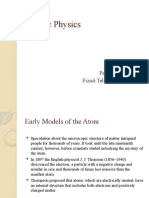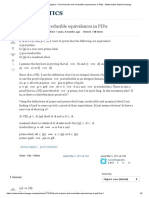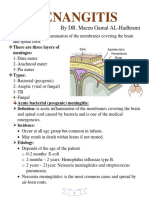0 ratings0% found this document useful (0 votes)
372 viewsProject On Atomic Structure
Project On Atomic Structure
Uploaded by
swati0611J.J. Thomson discovered the electron in 1897 through experiments with cathode rays. His experiments showed that atoms have internal structure rather than being indivisible units. Later discoveries found that atoms contain a small, dense nucleus surrounded by electrons in probabilistic orbits. This led to the development of quantum mechanical models that more accurately describe the atomic structure.
Copyright:
Attribution Non-Commercial (BY-NC)
Available Formats
Download as PPT, PDF, TXT or read online from Scribd
Project On Atomic Structure
Project On Atomic Structure
Uploaded by
swati06110 ratings0% found this document useful (0 votes)
372 views13 pagesJ.J. Thomson discovered the electron in 1897 through experiments with cathode rays. His experiments showed that atoms have internal structure rather than being indivisible units. Later discoveries found that atoms contain a small, dense nucleus surrounded by electrons in probabilistic orbits. This led to the development of quantum mechanical models that more accurately describe the atomic structure.
Original Title
5559501-Project-on-Atomic-Structure
Copyright
© Attribution Non-Commercial (BY-NC)
Available Formats
PPT, PDF, TXT or read online from Scribd
Share this document
Did you find this document useful?
Is this content inappropriate?
J.J. Thomson discovered the electron in 1897 through experiments with cathode rays. His experiments showed that atoms have internal structure rather than being indivisible units. Later discoveries found that atoms contain a small, dense nucleus surrounded by electrons in probabilistic orbits. This led to the development of quantum mechanical models that more accurately describe the atomic structure.
Copyright:
Attribution Non-Commercial (BY-NC)
Available Formats
Download as PPT, PDF, TXT or read online from Scribd
Download as ppt, pdf, or txt
0 ratings0% found this document useful (0 votes)
372 views13 pagesProject On Atomic Structure
Project On Atomic Structure
Uploaded by
swati0611J.J. Thomson discovered the electron in 1897 through experiments with cathode rays. His experiments showed that atoms have internal structure rather than being indivisible units. Later discoveries found that atoms contain a small, dense nucleus surrounded by electrons in probabilistic orbits. This led to the development of quantum mechanical models that more accurately describe the atomic structure.
Copyright:
Attribution Non-Commercial (BY-NC)
Available Formats
Download as PPT, PDF, TXT or read online from Scribd
Download as ppt, pdf, or txt
You are on page 1of 13
DISCOVERY OF ELECTRONS
• Hundred years ago, amidst glowing glass tubes
and the hum of electricity, the British physicist
J.J Thomson. was venturing into the interior of
the atom. At the Cavendish Laboratory at
Cambridge University, Thomson was
experimenting with currents of electricity inside
empty glass tubes. He was investigating a long-
standing puzzle known as "cathode rays." His
experiments prompted him to make a bold
proposal: these mysterious rays are streams of
particles much smaller than atoms, they are in J.J Thomson
fact minuscule pieces of atoms. He called these
particles "corpuscles," and suggested that they
might make up all of the matter in atoms. It was
startling to imagine a particle residing inside the
atom--most people thought that the atom was
indivisible, the most fundamental unit of
matter.
Cathode ray tube
• During the 1880s and ’90s scientists searched
cathode rays for the carrier of the electrical properties in
matter. Their work culminated in the discovery by English
physicist J.J. Thomson of the electron in 1897. The
existence of the electron showed that the 2,000-year-old
conception of the atom as a homogeneous particle was
wrong and that in fact the atom has a complex structure.
• Cathode-ray studies began in 1854 when
Heinrich Geissler, a glassblower and technical assistant
to the German physicist Julius Plücker, improved the
vacuum tube. Plücker discovered cathode rays in 1858
by sealing two electrodes inside the tube, evacuating the
air, and forcing electric current between the electrodes.
He found a green glow on the wall of his glass tube and
attributed it to rays emanating from the cathode. In
1869, with better vacuums, Plücker’s pupil
Johann W. Hittorf saw a shadow cast by an object placed
in front of the cathode. The shadow proved that the
cathode rays originated from the cathode. The English
physicist and chemist William Crookes investigated
cathode rays in 1879 and found that they were bent by a
magnetic field; the direction of deflection suggested that
they were negatively charged particles. As the
luminescence did not depend on what gas had been in
the vacuum or what metal the electrodes were made of,
he surmised that the rays were a property of the electric
current itself. As a result of Crookes’s work, cathode rays
were widely studied, and the tubes came to be called
Crookes tubes
CANAL RAYS
Anode rays (or Canal rays) were observed
in experiments by a German scientist,
Eugen Goldstein, in 1886. Goldstein used a
gas discharge tube which had a perforated
cathode. A "ray" is produced in the holes
(canals) in the cathode and travels in a
direction opposite to the "cathode rays,"
which are streams of electrons. Goldstein
called these positive rays "Kanalstrahlen" -
canal rays because it looks like they are
passing through a canal. In 1907 a study of
how this "ray" was deflected in a
magnetic field, revealed that the particles
making up the ray were not all the same
mass. The lightest, formed when there
was a little hydrogen in the tube, was
calculated to be 1837 times as massive as
an electron. They were protons
Discovery of the Neutron
• It is remarkable that the neutron was not
discovered until 1932 when James Chadwick
used scattering data to calculate the mass of
this neutral particle. Since the time of
Rutherford it had been known that the
atomic mass number A of nuclei is a bit more
than twice the atomic number Z for most
atoms and that essentially all the mass of the
atom is concentrated in the relatively tiny
nucleus. As of about 1930 it was presumed
that the fundamental particles were protons
and electrons, but that required that
somehow a number of electrons were bound
in the nucleus to partially cancel the charge
of A protons. But by this time it was known
from the uncertainty principle and from "
particle-in-a-box" type confinement
calculations that there just wasn't enough
energy available to contain electrons in the
nucleus.
J. J. Thomson's raisin bread model
(plum pudding model)
• J. J. Thomson considered that the
structure of an atom is something
like a raisin bread, so that his
atomic model is sometimes called
the raisin bread model. He
assumed that the basic body of an
atom is a spherical object
containing N electrons confined in
homogeneous jellylike but relatively
massive positive charge distribution
whose total charge cancels that of
the N electrons. The schematic
drawing of this model is shown in
the following figure. Thomson's
model is sometimes dubbed a
plum pudding model.
RUTHERFORD’S ALPHA
SCATTERING EXPERIMENT
• In the years 1909-1911 Ernest Ruthefordand
his students - Hans Geiger (1882-1945) and
Ernest Marsden conducted some
experiments to search the problem of alpha
particles scattering by the thin gold-leaf.
Rutheford knew that the particles contain the
2e charge. The experiment caused the
creation of the new model of atom - the
"planetary" model.
Rutheford suggested to hit the gold-leaf
(picture no. 1) with fast alpha particles from
the source 214Po. (The source R was in the
lead lining F). The particles felt from the
source on the gold-leaf E and were observed
by the microscope M. The whole experiment
was in the metal lining A and was covered
with the glass plate P. The instrument was
attached to the footing B. The gold leaf was
about 5*10-7 meter thick. The scientist knew
that reckoning the scattering angle could say
much about the structure of atoms of the
gold-leaf.
• Rutheford made a theoretical analysis of
angles of scattering in accordance with
Thomson's theory of atom and in accordance
with his own theory. He assumed that atom
consisted of positive charged nucleus and
negative charged electrons circling around
the nucleus. Then his theoretic calculations
he compared with the experiment result.
Alpha particles going through atom created
in accordance with the "plum cake" model
wouldn't be strong abberated because the
electric field in that atom wouldn't be strong.
In the model created by Rutheford the field is
much stronger near to the nucleus, so some
of alpha particles are much more abberated.
The other going in the far distance to the
nucleus are almost not at all abberated. The
probability that any alpha particle will hit the
nucleus is small but there is such a chance.
PLANETARY MODEL OF ATOM BY
BOHR
• The Bohr Model is probably familar as • This similarity between a planetary
the "planetary model" of the atom model and the Bohr Model of the atom
illustrated in the adjacent figure that, for ultimately arises because the attractive
example, is used as a symbol for atomic gravitational force in a solar system and
energy (a bit of a misnomer, since the the attractive Coulomb (electrical) force
energy in "atomic energy" is actually the between the positively charged nucleus
energy of the nucleus, rather than the and the negatively charged electrons in
entire atom). In the Bohr Model the an atom are mathematically of the same
neutrons and protons (symbolized by red form. (The form is the same, but the
and blue balls in the adjacent image) intrinsic strength of the Coulomb
occupy a dense central region called the interaction is much larger than that of
nucleus, and the electrons orbit the the gravitational interaction; in addition,
nucleus much like planets orbiting the there are positive and negative electrical
Sun (but the orbits are not confined to a charges so the Coulomb interaction can
plane as is approximately true in the be either attractive or repulsive, but
Solar System). The adjacent image is not gravitation is always attractive in our
to scale since in the realistic case the present Universe.)
radius of the nucleus is about 100,000
times smaller than the radius of the
entire atom, and as far as we can tell
electrons are point particles without a
physical extent
QUANTUM MECHANICAL MODEL
• According to the Principles of Quantum Mechanics electrons are
distributed around the nucleus in "probability regions". These
probability regions are called "atomic orbitals". According to Quantum
Mechanics, these orbitals are mathematically defined and are
described by a uniquely different math function for each electron in
the atom called an "eigen function" and a differential equation
generated by the following equation:
• H(eigen function) = Energy ( eigen function)
• The H in the above equation stands for a mathematical operator called
the Hamiltonian. We should be familiar with math operators since we
have been dealing with them since grade school. The addition
operator has to operate upon two numbers one that appears on its left
and the other on its right. For example the addition operator operates
upon the number 4 and 3 and the result of that operation as all knows
would be 7. We have subtraction, multiplier, division,common log,
natural log,exponentiation,etc. The Hamiltonian operator is kinda like
these but much more complex. The result of the Hamiltonian operator
operating on the eigen function of an electron is to generate a
differential equation. Differential equations often have more than one
root or solution which is not new to those who have had a first year
algebra course where quadratic equations are studied. However, one
property of differential equations that might be new to you is the fact
that differential equations cannot be solved exactly. We must use
approximation methods to extract any roots out of the equation, and
those roots or solutions will be approximate solutions.
You might also like
- Mechanical Properties of SolidsDocument37 pagesMechanical Properties of SolidsRahul Pugazhendi100% (1)
- Project On Atomic StructureDocument13 pagesProject On Atomic Structuread4982% (83)
- Chemistry Project Work: Submitted To:-Miss. M.DolareDocument24 pagesChemistry Project Work: Submitted To:-Miss. M.DolareJahnvi DongreNo ratings yet
- Physics Project (Final)Document17 pagesPhysics Project (Final)Namrata Agarwal0% (1)
- Structure of Atom ProjectDocument21 pagesStructure of Atom ProjectJaisam JNo ratings yet
- Nuclear ReactorDocument13 pagesNuclear ReactorMouth with No teethNo ratings yet
- 11 Chemistry Notes Ch04 Chemical Bonding and Molecular StructureDocument25 pages11 Chemistry Notes Ch04 Chemical Bonding and Molecular StructureRoyNo ratings yet
- Physics Investigatory Project Abhishek Class Xii PDFDocument19 pagesPhysics Investigatory Project Abhishek Class Xii PDFRahulNo ratings yet
- Nuclear Physics Project Class 12Document9 pagesNuclear Physics Project Class 12Rishabh vermaNo ratings yet
- Physics ProjectDocument11 pagesPhysics ProjectYouTubeFleX OPNo ratings yet
- Physics InvestigatoryDocument24 pagesPhysics InvestigatoryAarti Sharma100% (1)
- Project On CyclotronDocument13 pagesProject On CyclotronYuvan SivaNo ratings yet
- Reaction Mechanism Handwritten NoteDocument53 pagesReaction Mechanism Handwritten NoteDont KnowNo ratings yet
- Experiment No-1 Objective: - Equipment RequiredDocument3 pagesExperiment No-1 Objective: - Equipment RequiredwondieNo ratings yet
- Links of XII Physics Investigatory Project Allowtm - 221210 - 105608Document2 pagesLinks of XII Physics Investigatory Project Allowtm - 221210 - 105608Stuti KarnNo ratings yet
- Physics ProjectDocument12 pagesPhysics Projectcharul sahu100% (2)
- Project Report On SemiconductorsDocument6 pagesProject Report On SemiconductorsokgoogleNo ratings yet
- Chemistryprojec On CorrosionDocument23 pagesChemistryprojec On CorrosionSandeep Kumar Yadav100% (1)
- SemiconductorsDocument6 pagesSemiconductorsSargam PantNo ratings yet
- SuryanamaskarDocument7 pagesSuryanamaskarArchana KollaNo ratings yet
- Physics Practical Project For Class XIIDocument18 pagesPhysics Practical Project For Class XIIManoj Kumar SinghNo ratings yet
- Project File 2Document18 pagesProject File 2Adarsh SrivastavaNo ratings yet
- AC GENERATORS (Physics Project)Document41 pagesAC GENERATORS (Physics Project)Darshan Patil0% (1)
- DAV PUBLIC SCHOOL (Physics) XII ADocument14 pagesDAV PUBLIC SCHOOL (Physics) XII AAnish SahooNo ratings yet
- A Project On Radioactive ElementsDocument23 pagesA Project On Radioactive ElementsMK Jas75% (4)
- Effect of Mass On Terminal VelocityDocument5 pagesEffect of Mass On Terminal VelocitySanjay KhandelwalNo ratings yet
- Biology Project HUMAN EVOLUTIONDocument12 pagesBiology Project HUMAN EVOLUTIONanonymous user 345No ratings yet
- D SanthoshDocument17 pagesD Santhoshsreejith9thattentive100% (1)
- 4 - VBT and CFT PDFDocument5 pages4 - VBT and CFT PDFSesi WinarniNo ratings yet
- Physics Investigatory Project CbseDocument17 pagesPhysics Investigatory Project CbseKavin PatelNo ratings yet
- Physics XII CH 6 Physics Assertion Reasoning Electromagnetic InductionDocument6 pagesPhysics XII CH 6 Physics Assertion Reasoning Electromagnetic InductionNjan KL16么PorottaNo ratings yet
- Electromagnetic Waves Class 12 Physics Notes Chapter 8: History of EMWDocument7 pagesElectromagnetic Waves Class 12 Physics Notes Chapter 8: History of EMWShaku Joshi100% (1)
- Class 12th Chemistry Project On Electrochemical CellsDocument9 pagesClass 12th Chemistry Project On Electrochemical Cellsobi-wan kenobiNo ratings yet
- Physics Investegatory ProjectDocument14 pagesPhysics Investegatory Projectbalaji s0% (1)
- Cyclotron 171219084805Document14 pagesCyclotron 171219084805Sanjay Bagra67% (3)
- Chemistry Project - ConductivityDocument19 pagesChemistry Project - ConductivityUmang AroraNo ratings yet
- Chemistry Investigatory ProjectDocument11 pagesChemistry Investigatory ProjectAnonymous Creations0% (2)
- Physics Project - Mapping The Magnetic FieldDocument26 pagesPhysics Project - Mapping The Magnetic Fieldmohammadumair2006No ratings yet
- 12 Chemistry Notes Ch08 The Dblock F-Block ElementsDocument4 pages12 Chemistry Notes Ch08 The Dblock F-Block ElementsSwaroop SurendraNo ratings yet
- 03a.magnetism (171 - 201)Document31 pages03a.magnetism (171 - 201)Mupli RajeshNo ratings yet
- Physics Investigatory Project, on full wave rectifier, based on NCERTDocument16 pagesPhysics Investigatory Project, on full wave rectifier, based on NCERTxavierdaniel1202No ratings yet
- STD-12 Physics Investigatory Project List With Certificate and AcknowledgementDocument8 pagesSTD-12 Physics Investigatory Project List With Certificate and AcknowledgementrajdevsinhkapletiaNo ratings yet
- Physics Investigatory Project 2Document23 pagesPhysics Investigatory Project 2mallicksaad07No ratings yet
- Chem Workshop - Question Paper Compilation (Class Xi)Document212 pagesChem Workshop - Question Paper Compilation (Class Xi)aarzoopatel08100% (3)
- Sap Phy Investigatory ProjectDocument15 pagesSap Phy Investigatory ProjectApsara PhiloNo ratings yet
- ART INTEGRATED PROJECT - PhysicsDocument6 pagesART INTEGRATED PROJECT - PhysicsShifa SiddiquiNo ratings yet
- Physics Project Class XII 2021 22 Investigatory ProjectDocument16 pagesPhysics Project Class XII 2021 22 Investigatory Projectchetak7108No ratings yet
- Physics Project Class XII 2021 22 Investigatory ProjectDocument16 pagesPhysics Project Class XII 2021 22 Investigatory Projectnaga06557No ratings yet
- Study of The Effect of Metal Coupling On The Rusting IronDocument15 pagesStudy of The Effect of Metal Coupling On The Rusting IronAyush kumar100% (2)
- Wireless EnergyDocument28 pagesWireless EnergyR A V INo ratings yet
- Acknowledgment: Electrochemical CellDocument12 pagesAcknowledgment: Electrochemical CellMSD PrajwalNo ratings yet
- Project On SemiconductorsDocument10 pagesProject On SemiconductorsKrishna Tiwari100% (1)
- Chemistry Class 12 Investigatorty ProjectDocument24 pagesChemistry Class 12 Investigatorty Projectzeeshan khan زشان خانNo ratings yet
- Physics Investigatory ProjectDocument13 pagesPhysics Investigatory ProjectDêêpák Sîñgh ÑîtwálNo ratings yet
- Evolution of Atomic StructureDocument17 pagesEvolution of Atomic StructurePIO DASNo ratings yet
- ContentDocument17 pagesContentpalanir284100% (1)
- Atomic Physics, Petcu George-DenisDocument13 pagesAtomic Physics, Petcu George-DenisDenis PetcuNo ratings yet
- Development of Atomic TheoryDocument8 pagesDevelopment of Atomic TheoryPedro NepomucenoNo ratings yet
- Atomic Structure ModelsDocument3 pagesAtomic Structure Modelsom.kumarNo ratings yet
- Chemistry Project Fa 4 On ModelsDocument16 pagesChemistry Project Fa 4 On ModelsVARIGALA SAI CHARAN GUPTANo ratings yet
- Mostafa Bengourine & Widad Benhanyn - End-Of-Term-PaperDocument30 pagesMostafa Bengourine & Widad Benhanyn - End-Of-Term-PaperMostafa BengourineNo ratings yet
- 2d10 UnderDocument4 pages2d10 UnderAxel RagnarsonNo ratings yet
- Adhesives in Civil EngineeringDocument346 pagesAdhesives in Civil EngineeringÇağrı KARABİLLİOĞLU100% (1)
- CZBBDocument4 pagesCZBBnirajpdNo ratings yet
- AryabhataDocument4 pagesAryabhataIsmail MswNo ratings yet
- TUTORIAL - Court House - Courtroom - Indian ContextDocument14 pagesTUTORIAL - Court House - Courtroom - Indian ContextPrathamesh MamidwarNo ratings yet
- CR750-CR751 Controller Troubleshooting Bfp-A8871pDocument72 pagesCR750-CR751 Controller Troubleshooting Bfp-A8871pBarry Weller100% (1)
- Installation and Commisioning of Eagle ControllerDocument42 pagesInstallation and Commisioning of Eagle ControllerAbdul Rehman ZafarNo ratings yet
- Chapter 2Document18 pagesChapter 2dkburning.ti4No ratings yet
- Goal Setting WorksheetDocument7 pagesGoal Setting Worksheetdeeptimane1986No ratings yet
- Page Replacement: Sashikanta TaoremDocument35 pagesPage Replacement: Sashikanta Taoremgauraviter20No ratings yet
- Mila Amor V. Reyes, MD, FPSP Anatomic and Clinical PathologistDocument41 pagesMila Amor V. Reyes, MD, FPSP Anatomic and Clinical PathologistFranco Rommel ReyesNo ratings yet
- Thin-Walled Structures: B. Jáger, L. Dunai, B. KövesdiDocument13 pagesThin-Walled Structures: B. Jáger, L. Dunai, B. KövesdiAsr FlowerNo ratings yet
- 772 HDocument18 pages772 HwilliamsidhartaNo ratings yet
- Summer Textile Internship: Technocraft Industries India LimitedDocument80 pagesSummer Textile Internship: Technocraft Industries India LimitedSuraj KediaNo ratings yet
- Abstract Algebra - Proof of Prime and Irreducible Equivalences in PIDs - Mathematics Stack ExchangeDocument2 pagesAbstract Algebra - Proof of Prime and Irreducible Equivalences in PIDs - Mathematics Stack ExchangeMohanNo ratings yet
- S 11Document1 pageS 11Audra ToopNo ratings yet
- LogDocument117 pagesLogÁlvaro KramarNo ratings yet
- KerisDocument2 pagesKerisFatin Raniahthifal AdiwijayaNo ratings yet
- US Internal Revenue Service: F1099oid - 1992Document5 pagesUS Internal Revenue Service: F1099oid - 1992IRSNo ratings yet
- Kau-06 Mech - engg-II Set-A 1Document30 pagesKau-06 Mech - engg-II Set-A 1american_guy100% (1)
- LD New Dog Shopping ListDocument2 pagesLD New Dog Shopping ListAbdullah TheNo ratings yet
- Formula SheetDocument1 pageFormula SheetHabeba EmadNo ratings yet
- Bacteriolgy Catalase (+), Gram (+) Cocci Part 1Document4 pagesBacteriolgy Catalase (+), Gram (+) Cocci Part 1Shaniah xxNo ratings yet
- Business Update and Outlook 2021: February 15, 2021Document19 pagesBusiness Update and Outlook 2021: February 15, 2021sdsddNo ratings yet
- Bfs Deaerator RFQDocument2 pagesBfs Deaerator RFQSrinivasa Rao VenkumahanthiNo ratings yet
- Secret CB Vol 18Document81 pagesSecret CB Vol 18luistorcatt72No ratings yet
- Statue of Liberty LPDocument4 pagesStatue of Liberty LPapi-271869316No ratings yet
- 02 MenangitisDocument4 pages02 MenangitisMaeen Gamal AlhadhramiNo ratings yet
- Steering Knuckles 4wd CHEVROLET S10Document4 pagesSteering Knuckles 4wd CHEVROLET S10Maxi SardiNo ratings yet

























































































